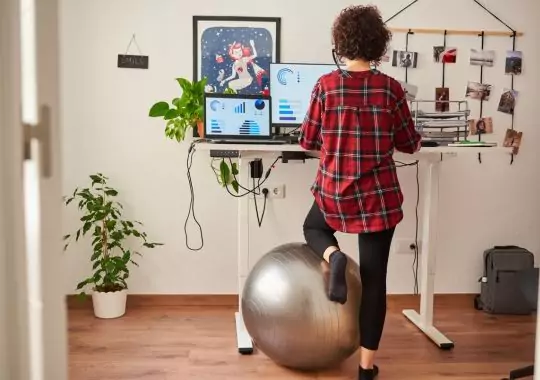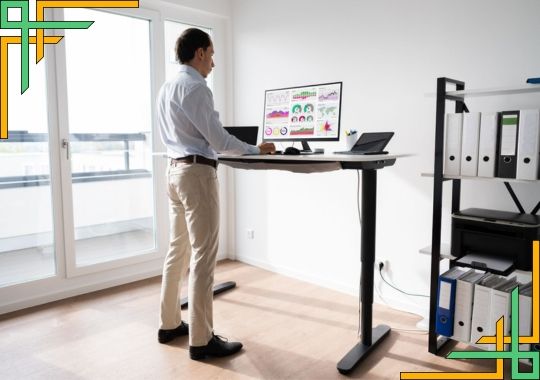As Amazon affiliates we may earn a commission if you purchase a product at no cost to you.
In recent years, standing desks have gained popularity as a potential solution to the sedentary lifestyle associated with traditional office setups. Proponents claim that standing desks offer numerous health benefits, while skeptics question their effectiveness. In this article, we aim to uncover the truth behind the controversy surrounding the health benefits of standing desks.
Understanding Standing Desks
Standing desks, also known as sit-stand desks or height-adjustable desks, allow users to switch between sitting and standing positions while working. They typically feature a height-adjustable mechanism that enables users to customize their desk height to suit their comfort and ergonomic needs.
The Controversy Surrounding the Health Benefits
The controversy surrounding the health benefits of standing desks stems from conflicting research findings and differing perspectives. While some studies suggest potential advantages, others highlight potential drawbacks and limitations.
Skeptics argue that standing for extended periods may lead to musculoskeletal discomfort, fatigue, and an increased risk of varicose veins. They argue that the benefits of standing desks may be overstated and that there is a lack of substantial evidence supporting their long-term health benefits.
Proponents, on the other hand, highlight the potential advantages of standing desks, such as improved posture, reduced back pain, increased calorie expenditure, and enhanced blood circulation. They argue that standing desks encourage physical activity and help break the sedentary behavior associated with excessive sitting.
It is important to note that individual experiences with standing desks can vary. Factors such as individual fitness levels, ergonomic setup, and personal preferences play a significant role in determining the effectiveness and comfort of using a standing desk.

The Potential Health Benefits of Standing Desks
Standing desks like AIZ Mobile Standing Desk have been associated with several potential health benefits. Let's explore three key advantages: improved posture and reduced back pain, increased calorie expenditure and weight management, and enhanced blood circulation and reduced risk of chronic diseases.
Improved Posture and Reduced Back Pain
One of the touted benefits of standing desks is their potential to promote better posture and alleviate back pain. When properly set up, standing desks can encourage a more upright position, which helps align the spine and reduce strain on the lower back. By avoiding prolonged sitting and its associated slouched posture, individuals may experience improved spinal alignment and reduced back pain over time.
However, it's important to note that standing for extended periods can also lead to muscle fatigue and discomfort. It's crucial to find a balance between standing and sitting, allowing for breaks and changes in posture throughout the day.
Increased Calorie Expenditure and Weight Management
Standing desks offer the potential for increased calorie expenditure compared to sitting for long periods. When standing, the body engages more muscles, resulting in a slightly higher energy expenditure. While the difference may not be significant, it can contribute to a more active lifestyle and aid in weight management efforts.
It's worth noting that standing alone is not a substitute for regular exercise or physical activity. Incorporating movement breaks, stretching, and regular exercise into your routine is essential for overall health and weight management.
Enhanced Blood Circulation and Reduced Risk of Chronic Diseases
Sitting for prolonged periods can negatively impact blood circulation, leading to issues such as swollen ankles and increased risk of cardiovascular diseases. Standing desks promote increased movement and muscle engagement, which can help improve blood circulation throughout the body.
By reducing sedentary behavior, standing desks may contribute to a lower risk of chronic diseases such as obesity, type 2 diabetes, and heart disease. However, it's important to emphasize that standing alone is not a panacea for these conditions. A holistic approach that includes regular exercise, a balanced diet, and other healthy lifestyle choices is crucial for long-term well-being.
While standing desks offer potential health benefits, it's important to use them as part of a comprehensive approach to wellness. Finding the right balance between sitting and standing, incorporating movement breaks, and maintaining proper ergonomic alignment are key factors in optimizing the potential advantages of standing desks.
Potential Drawbacks and Considerations
While standing desks offer potential health benefits, it's essential to consider their potential drawbacks and find the right balance between sitting and standing. Let's explore three key considerations: muscular fatigue and discomfort, impact on productivity and focus, and the importance of alternating between sitting and standing.
Muscular Fatigue and Discomfort
Standing for long periods can lead to muscular fatigue and discomfort. The prolonged activation of certain muscles, especially in the lower limbs and feet, can cause strain and fatigue. This can be particularly problematic if the standing desk setup is not ergonomically optimized or if supportive footwear is not used.
To minimize muscular fatigue and discomfort, it's important to incorporate regular breaks, change positions, and consider using supportive footwear or anti-fatigue mats to reduce the strain on your feet and legs. Finding a balance between sitting and standing throughout the day can also help alleviate these issues.
Impact on Productivity and Focus
While standing desks can promote movement and engagement, some individuals may experience challenges in terms of productivity and focus. Standing for extended periods may cause distraction or discomfort, potentially impacting concentration and productivity. It's important to assess your personal work requirements and preferences to determine if a standing desk is suitable for your specific tasks.
Adjusting to a standing desk may require a transition period. Starting with shorter periods of standing and gradually increasing the duration can help your body adapt and minimize any potential negative impact on productivity.
Finding the Right Balance: Alternating Between Sitting and Standing
To optimize the benefits of a standing desk while mitigating potential drawbacks, it's crucial to find the right balance between sitting and standing. Experts suggest adopting a posture transition strategy, such as the 50-30-20 rule. This involves spending 50% of your time sitting, 30% standing, and 20% engaging in other forms of movement or walking.
Alternating between sitting and standing throughout the day allows for greater movement, reduces prolonged static positions, and helps prevent muscular fatigue. Finding a rhythm that works for you, based on your comfort, task requirements, and overall well-being, is key to making the most of a standing desk setup.

Best Practices for Using Standing Desks
To make the most of your Standing desk like soges Mobile Standing DeskAdjustable Height experience and ensure a healthy and comfortable workspace, it's important to follow best practices. Let's explore three key practices: gradual transition and adjustment period, listening to your body and responding to discomfort, and consulting with a healthcare professional if needed.
Gradual Transition and Adjustment Period
When transitioning to a standing desk, it's best to do so gradually. Follow these guidelines for a smooth transition:
- Start by incorporating short standing periods throughout your workday, gradually increasing the duration over time.
- Begin with 15-30 minutes of standing, and gradually build up to longer periods.
- Pay attention to how your body responds to the increased standing time and make adjustments as necessary.
A gradual transition allows your body to adapt to the new position and reduces the risk of muscle fatigue or discomfort.
Listening to Your Body and Responding to Discomfort
Each individual's body is unique, and it's important to listen to your body's signals and respond accordingly.
- If you experience discomfort or fatigue while standing, try adjusting your posture, taking breaks, or alternating between sitting and standing.
- Incorporate regular movement breaks and stretching exercises to relieve tension and maintain flexibility.
- Experiment with different standing positions, such as using a footrest or shifting weight between legs, to find what feels most comfortable for you.
Remember to pay attention to your body's needs and make adjustments to optimize your standing desk setup.
Consulting with a Healthcare Professional if Needed
If you have pre-existing health conditions or concerns about using a standing desk, it's advisable to consult with a healthcare professional. They can provide personalized guidance based on your specific needs and offer recommendations tailored to your situation.
A healthcare professional can help assess your ergonomic setup, provide exercises or stretches to alleviate discomfort, and address any concerns related to your health and well-being.
Their expertise will ensure that you use your standing desk in a way that aligns with your health goals and supports your overall well-being.
It's important to find a balance between sitting and standing, incorporate regular movement breaks, and listen to your body's cues to create a healthy and comfortable work environment.
Weighing the Pros and Cons of Standing Desks
Standing desks have gained popularity due to the potential health benefits they offer. However, it's important to weigh the pros and cons to make an informed decision about incorporating them into your workspace.
The pros of standing desks include improved posture, reduced back pain, increased calorie expenditure, and enhanced blood circulation. They can be valuable tools in combating the negative effects of prolonged sitting.
On the other hand, potential cons include muscular fatigue and discomfort, the impact on productivity and focus, and the importance of finding the right balance between sitting and standing. It's crucial to optimize your setup, incorporate movement breaks, and listen to your body to minimize any drawbacks.
Making Informed Decisions for Your Health and Well-being
When considering a standing desk, it's essential to make informed decisions that prioritize your health and well-being. Here are some key considerations:
- Understand the risks of prolonged sitting and the potential benefits of standing desks.
- Optimize your standing desk setup by setting the correct height and ergonomic alignment.
- Incorporate movement breaks, stretching exercises, and regular physical activity into your routine.
- Find the right balance between sitting and standing, considering your comfort, task requirements, and overall well-being.
- Listen to your body and make adjustments to alleviate discomfort or fatigue.
- Consult with a healthcare professional if you have pre-existing health conditions or concerns.
Conclusion
Standing desks have become increasingly popular in recent years due to the potential health benefits they offer. While there is some evidence to suggest that standing desks may help reduce the risk of certain health issues, such as obesity and back pain, more research is needed to fully understand the long-term effects of prolonged standing.
Recommended Article

Frequently Asked Questions FAQs
Are standing desks actually good for your health?
Standing desks offer potential health benefits such as improved posture, reduced back pain, increased calorie expenditure, and enhanced blood circulation. However, it's important to find the right balance between sitting and standing and incorporate movement breaks for optimal results.
Can standing desks lead to discomfort or fatigue?
Standing for prolonged periods can cause muscular fatigue and discomfort. It's crucial to optimize your setup, incorporate regular movement breaks, and listen to your body's cues to minimize any potential drawbacks and maintain a comfortable work environment.
How do I transition to using a standing desk?
Transition gradually by starting with shorter periods of standing and gradually increasing the duration over time. Pay attention to your body's response and make adjustments as needed. It's important to find the right balance and consider your comfort, task requirements, and overall well-being.










